35 Brunswick Street West
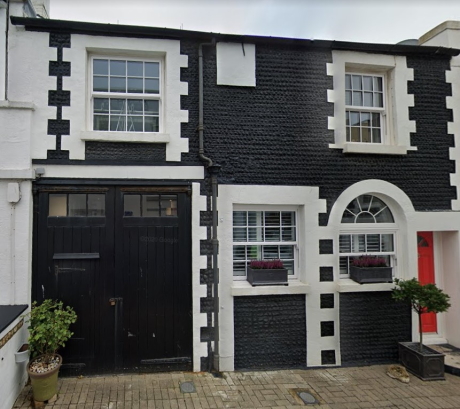
35 Brunswick Street West in 2020
35 Brunswick Street West is a locally-listed building distinguished by its traditional use of cobbles on its facade. In appearance its strong black and white design complements the house diagonally opposite, which was used as a tailor’s shop in the 19th century. The building lies almost opposite what was the area’s public house, The Star of Brunswick, and is at the nexus of service streets that contained trades such as grocer, butcher, bootmaker and the already mentioned tailor. Was its outer design altered at any stage to reflect the businesses or houses around it?
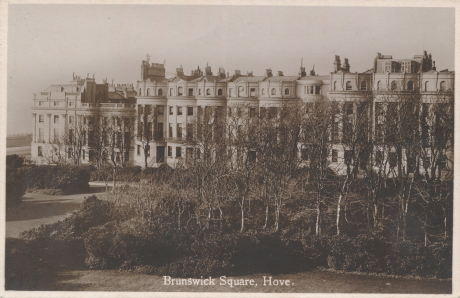
46 Brunswick Square is on the west side just to the right of this early 1900s view
The present number 35 Brunswick Street West aligns to and would have been designed to serve as a stable to the grand house of 46 Brunswick Square. Prior to the re-numbering of the street in 1924 our house would have been number 46, reflecting the number of the house it was built to serve in the Square. However, there is no evidence that the occupiers of the stables were ever associated with the main house.
The electoral roll and Brighton Directory of 1848 show a George Samuel Ford residing at 46 Brunswick Square. His wife Hannah, two of his daughters and a grandchild appear in the 1851 census at the main house but none of their servants seem to have a role or residence that links them to the adjoining stable. The 1851 census shows that George Ford, a solicitor, remained at their Hanover Square address in London with their two sons, suggesting that their Brunswick Square address was a second home with the core of their servants retained in London.
The 1854 Street Directory shows a Ralph Blegborough as the occupant of 46 Brunswick Square but prior to that he is listed in 1847 at Standen Hall, Pendleton Lancashire. The Eastbourne Chronicle reported that Ralph Blegborough died at 46 Brunswick Square in 1869 but his widow Jane remained there until 1875. Jane Blegborough nee Aspinall and Ralph Blegborough both had links to Standen Hall, Lancashire, which then, as now, remains the seat of the Aspinall family. In 1861, their servants at number 46 were primarily female domestic servants other than a footman and a butler.
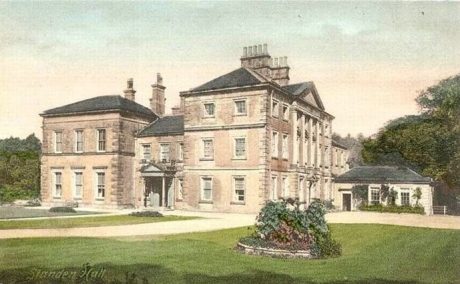
Standen Hall from an early 1900s postcard
The first confirmed use of our 46 Brunswick Street West comes in the 1871 census which shows 31-year-old Alfred Briggs born in Chatburn, Lancashire with his occupation given as Domestic Coachman. Residing with him are his wife Ellen, their six-year-old daughter Ellen, born in Hove, and Alfred’s brother-in-law, Edward Marshall, a gasfitter. Parish records show that Alfred Briggs had married Ellen Marshall at St Nicholas Church Brighton on 5th November 1864. His occupation was given as Coachman and he’s residing in Hove. We could speculate that he was here in Brunswick Street West as Brunswick Town is next door to Western Street where Ellen lived.
Alfred’s place of birth in Lancashire is less than 5 miles distance from Standen Hall the former home of the Blegboroughs prior to their living in Brunswick Square. This could be a coincidence or the Brigg’s may have provided services to the Blegboroughs in Lancashire.

St Nicholas Church Parish Record
Interestingly, his father Richard’s occupation is given as Blacksmith which may give some clue as to Alfred’s familiarity with horses. His wife Ellen is the daughter of Richard Marshall, described as an Eating-House Keeper of 16 Western Street, Brighton. Richard Marshall has previous connections himself to Brunswick Square appearing in the 1841 census as a manservant at 28 Brunswick Square. At the 1861 Census Alfred Briggs is single and appears to be at 13 Brunswick Street West with his occupation given as Coachman.
The 1851 census shows Alfred as the 4th of 7 children residing with his mother in Lancashire. His father, a blacksmith, is absent. The 1861 census shows the same family group as well as two grandchildren at the family home in Lancashire and this increased family burden may have been a possible reason for Alfred moving on to find his own path in Brunswick Town. Nevertheless, having left relative agricultural hardship and following on from his beginnings in Brunswick Town, Alfred moved in the same capacity to London, where the 1881 census finds him and his family living at 80 Portobello Rd. Alfred retired comfortably to Acton and at the time of his death in 1915 was sufficiently wealthy to leave a Will and probate of £1225 4s 9d equivalent in 2023 to approx. £161,247

80 Portobello Road in 2020
By 1881 our house is occupied by Thomas Lake, aged 30, born in Honiton, Devon with his wife Martha, aged 29, born Marland Devon and their 6-month-old son William who was born in Hove. It is not known when Thomas and Martha came to BSW, but Thomas’ origins may explain his desire to leave Devon and make a new life in Hove. The 1851 census shows a one-year-old Thomas living with his family in an almshouse with his father described as an agricultural labourer living on parish relief.
At the time of the 1881 census, Thomas gives his occupation as Flyman. Boarding with them is his 22-year-old sister Eliza Lake who is also described as a Flyman. When Thomas married Martha (nee Ayre) at St Andrews Church, Hove on 3rd December 1879 he gave his profession as Fly Proprietor. This suggests that by at least 1881 if not before, 46 Brunswick Street West was occupied by an independent coaching business without affiliation to any property in the main square.
By 1891 the Lake family have moved on to 10 Westbourne Mews Aldrington and have 5 children although their son William is not amongst them, suggesting he has died. Both the 1901 and 1911 censuses give the Lake family as remaining at the Westbourne Mews address. The 1901 census provides Thomas as both Cab Proprietor and Employer and his eldest surviving son, Thomas, as a cab driver. By 1911 Thomas describes himself as ‘cab man’ on own account i.e., self-employed. By 1911 the family of originally 10 children are seven surviving children with both parents alive. When Thomas Lake died in 1933, he left a will and effects to his family to the value of £675 19s 11d the equivalent value in 2023 of approx. £38,000. Again, the family appear to have prospered compared to their humble origins.
Returning to our property, the 1891 census finds its more occupants from the west country. Roger Walter, 31, born in Bradworthy, Devon and his wife Emma, 29, born in Hallabrow Somerset, are here along with their two young children, Maud aged five and William aged three. Roger Walter is described as a Cab Driver. In similar circumstances to the previous occupants Roger has come from a constrained agricultural background. In the 1871 census we find Roger as a 10-year-old living with his adult brother John, (a Smith), his sister Mary (a needlewoman) and his widowed mother who is receiving Parochial Relief. By 1885 Roger is in Hove and marrying Emma (nee Wyatt) at St Andrews Church Hove. He describes himself as a Coachman and she gives no occupation but is daughter of a miner. By 1901 Roger and his family are living at Farm Road Hove and he is a cab driver.
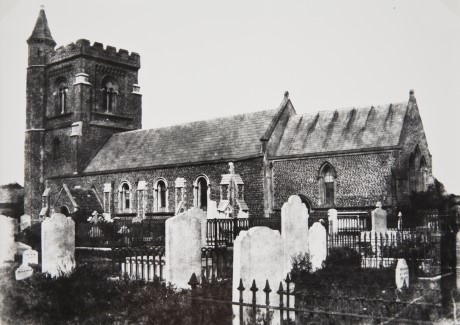
St Andrews Old Church 1860s 460px
Throughout the second half of the 19th century, we can see that 46 Brunswick Street West had a pattern of attracting young ambitious men prepared to leave the poverty and isolation of agricultural life for the attraction and opportunity that fashionable Brighton and Hove could give them. All the coachmen (and women) who lived here bettered themselves, becoming independent, self-employed and in relative wealth, but none appeared to remain for any duration at this address. This may be because of the limited space at what was designed as stables but it seems to have been a stepping- stone for further ambition away from any servitude.
The use of 46 Brunswick Street West as an independent stable or livery is supported by the address appearing in town directories between 1890 and 1893 for W Finnemore a Fly Proprietor and Jobmaster who is shown at both 20 and 46 in the street. William Finnemore appears to have been a successful independent Fly proprietor who is consistently shown at number 20 before moving to Farm Road, Hove. Number 46 may have been used as a subsidiary livery to support his main business at number 20 or vice versa.

The Sussex Agricultural Express ran a weekly advertisement between April and May 1893
It seems possible that the occupants of 46 may have been subcontracted to Finnemore. If the property was on leasehold and subcontracted this may explain why there was a high turnover of coachmen at 46 who moved on to their own independent businesses.
The next confirmed use of number 46 comes in 1921 when a planning application was made for alterations to the back premises of 46 Brunswick Square, formerly stables in Brunswick Street West. The proposed alteration of the stables seeks an ‘Exercising room’ on the left-hand side of the ground floor and a ‘food preparing room and store to the back of it’ on the right-hand side . But what sort of exercise was going to take place there? The first-floor proposal is for an Exhibition room to the front left side with a sitting room behind and a bedroom and store on the right-hand side.
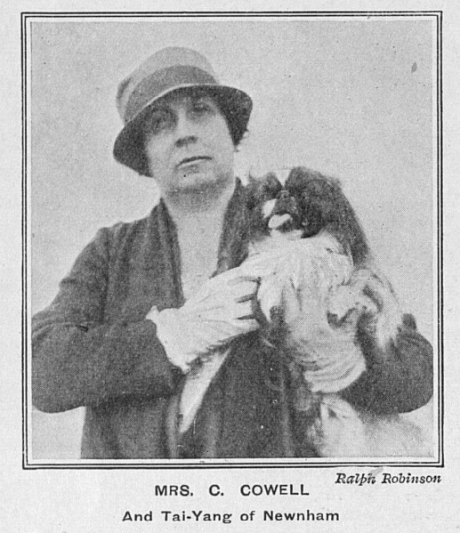
Mrs Cowell with one of her prized dogs
The proposal seems odd but the clue to the use of number 46 in 1921 is that the owners of 46 Brunswick Square were Mr and Mrs Herbert Cowell. So, it seems that the stables were always owned with the main house. Mrs Cowell appears to have been at the forefront of the newly emerging Kennel Association and was both a prize exhibitor of Pekinese dogs and a judge at championship dog shows. Thus, while the majority of Brunswick Street West mews premises evolved from the transport world of coach and horses to become garages and car repair services, number 46 remained firmly in the animal world moving from horses to dogs!
Research by Rachel Pope, March 2023
If you’re interested in getting involved with our history research, please contact the project leader at kevin@rth.org.uk
Return to Brunswick Street West page


